1968 Red Square demonstration
The 1968 Red Square demonstration (Russian: Демонстра́ция 25 а́вгуста 1968 го́да) took place in Moscow on 25 August 1968. It was a protest by eight demonstrators against the invasion of Czechoslovakia on the night of 20–21 August 1968 by the Soviet Union and its Warsaw Pact allies, crushing the Prague Spring, the challenge to centralised planning and censorship by communist leader Alexander Dubček.
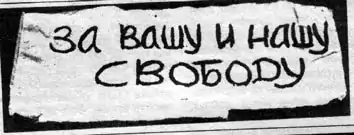
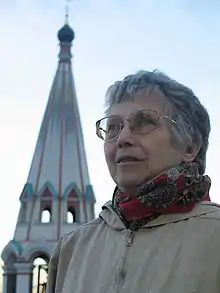
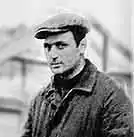
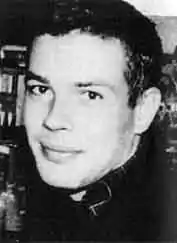
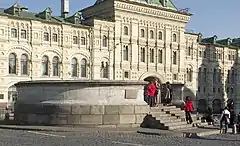 | |
| Date | 25 August 1968 |
|---|---|
| Time | Noon |
| Location | Lobnoye Mesto, Red Square, Moscow |
| Cause | Warsaw Pact invasion of Czechoslovakia |
| Participants | Larisa Bogoraz, Konstantin Babitsky, Vadim Delaunay, Vladimir Dremliuga, Pavel Litvinov, Natalya Gorbanevskaya, Viktor Fainberg, Tatiana Baeva |
The protest took place at the Lobnoye Mesto (Place of Proclamation) on Red Square next to the Kremlin, to avoid any accusation of a violation of public order. It was a non-violent, sit-down demonstration. However, all but one of the protestors was quickly and roughly arrested by police and plainclothes KGB men.
The protest, 25 August
The protest began at noon as eight protesters (Larisa Bogoraz, Konstantin Babitsky, Vadim Delaunay, Vladimir Dremliuga, Pavel Litvinov, Natalya Gorbanevskaya, Viktor Fainberg, and Tatiana Baeva) sat at the Lobnoye Mesto and held a small Czechoslovak flag and placards bearing various slogans:
- "We are losing our best friends" ("мы теряем лучших друзей"),
- "Ať žije svobodné a nezávislé Československo!" (Long live free and independent Czechoslovakia),
- "Shame to the occupiers" ("Позор оккупантам!"),
- "Hands off the ČSSR" ("Руки прочь от ЧССР!"),
- "For your freedom and ours" ("За вашу и нашу свободу!"),
- "Freedom for Dubček" ("Свободу Дубчеку!").
Within a few minutes, seven of the protesters were assaulted, brutally beaten and loaded into cars by KGB operatives. The Czechoslovak flag was broken, and the placards were confiscated. Since Natalya Gorbanevskaya had recently given birth, she was not made to stand trial. The other protesters convinced 21-year-old Tatiana Baeva to declare that she had been at the scene by accident, and she was released soon after.
The KGB failed to find out which protester was holding which banner; therefore, all the banners were attributed to each protester, except for Tatiana Baeva, who was released. The banners were branded by the KGB as "anti-Soviet".[1] [2]
Trial, 9-11 October 1968
During the investigation and trial, the defence revealed several inconsistencies in the accusations.[3] One of the eyewitnesses declared that he saw protesters leaving the GUM, a large store in the vicinity, even though this store is closed on Sundays. Additionally, all eyewitnesses happened to be from the same military division, even though they all claimed that they ended up on Red Square accidentally. However, these inconsistencies were not taken into account during the trial.
None of the demonstrators pleaded guilty.
Verdict and sentence
Lawyers for the defence (all Communist Party of the Soviet Union members appointed and paid for by the State) demonstrated that the protestors had acted without criminal intent.[4] but the protesters on trial all received sentences of up to several years imprisonment or exile and in two cases they were sent to psychiatric prison hospitals.
Vadim Delaunay and Vladimir Dremlyuga were sentenced to three years in a penal colony. Victor Fainberg, who had his teeth knocked out during the arrest, did not appear in court but was sent to a psychiatric prison. Larisa Bogoraz was sentenced to four years of exile to a remote Siberian settlement in the Irkutsk Region. Konstantin Babitsky was sentenced to three years of exile. Pavel Litvinov was sentenced to five years' exile. Natalya Gorbanevskaya was released the same day but later sent to a psychiatric prison.
In his "Attorney's waltz" singer and rights activist Yuliy Kim claimed that the sentences had been decided before the trial.[5] In another song, "Ilyich", Kim mentions Yuri Andropov's and Leonid Brezhnev's anger at the demonstration, and refers to three of the protestors by name -- Pavel Litvinov, Natalya Gorbanevskaya and Larisa Bogoraz.[6]
The story of the August 1968 demonstration is recounted in the 2005 documentary They Chose Freedom.
Belated public recognition
In 1990 (following the Velvet Revolution), seven of the protesters were awarded honorary citizenship of Prague.[7]
During the conflict in South Ossetia, August 2008, the former president of the Czech Republic, Václav Havel, expressed his sympathies for the protesters of 1968.[8] Czech Premier Mirek Topolánek recognized the heroism of the protesters with awards.[9]
There was no recognition on the part of the Russian government. On 24 August 2008, the similar demonstration with the slogan For your freedom and ours was held in the same place.[10]
On 25 August 2013, the 45th anniversary of the demonstration, Gorbanevskaya and several of her friends recreated the original protest,[11] again featuring the "For your freedom and ours" banner. Ten participants (among them Delaunay's son Sergey) were arrested almost immediately and taken to a police station. They were soon arraigned and released pending court appearance on charges of failing to secure prior permission for a political rally,[12] a misdemeanor under current Russian law.
In 2018, three participants at another repeat demonstration were arrested.[13]
References
- Andropov et al. to Politburo about Red Square demonstrators (5 September 1968, 2012-A), Bukovsky Archives.
- Andropov to the Central Committee. The Demonstration in Red Square Against the Warsaw Pact Invasion of Czechoslovakia. 20 September 1968, at Andrei Sakharov's archive, in Russian and translation into English, "Archived copy". Archived from the original on 12 October 2007. Retrieved 17 June 2007.
{{cite web}}: CS1 maint: archived copy as title (link) - "The trial of the Red Square demonstrators, 9-11 October 1968", A Chronicle of Current Events (4.1 31 October 1968).
- See speech Archived 25 September 2020 at the Wayback Machine in defense of V.Delaunay by his attorney S.V.Kallistratova (Речь адвоката Каллистратова, Софья Васильевна|С.В.Калистратовой в защиту Делоне, Вадим Николаевич|В.Делоне), in Russian.
- Yuly Kim, "The attorney's waltz" (Адвокатский вальс) (in Russian).
- Yuly Kim, "Ya sam sebe Iliich" (in Russian).
- "Čestné občanství hlavního města Prahy od roku 1990" [Honorary citizenship of Prague since 1990]. Portál hlavního města Prahy [Portal of Prague] (in Czech).
- Ярошевский, Виталий (21 August 2008). "На Лобном месте" [On the Lobnoe mesto]. Novaya Gazeta (in Russian). No. 61. Archived from the original on 4 September 2008.
- Premier Awarded Commemorative Medals to Ten Dissidents from 1968. Press Release of the government of the Czech Republic, 21 August 2008, http://www.vlada.cz/scripts/detail.php?id=40255
- Sophia Kishkovsky (25 August 2008). "Red Square protest echoes 1968". Herald Tribune. Archived from the original on 13 September 2008. Retrieved 31 August 2008.
- Photograph from 2013 recreation of the protest, from Gorbanevskaya's Livejournal blog,
- "Police release all Red Square detainees", in Russian, "Lenta" news stream, 25 August 2013 http://lenta.ru/news/2013/08/25/redsquare/
- Three people were arrested on red square for remembrance of the 1968 Red Square demonstration, Novaya Gazeta, 25 August 2018
Bibliography
- Gorbanevskaya, Natalya (1972). Red Square at Noon. New York: Holt, Rinehart and Winston. ISBN 978-0-03-085990-8.
- Alexeyeva, Lyudmila (1987). Soviet Dissent: Contemporary Movements for National, Religious, and Human Rights. Carol Pearce, John Glad (trans.). Middletown, Conn.: Wesleyan University Press. ISBN 0-8195-6176-2.
- Boobbyer, Philip (2005). Conscience, dissent and reform in Soviet Russia. Routledge. ISBN 0415331862.
External links
- "Natalia Gorbanevskaya: Red Square at Noon. What I remember of the demonstration". Prague Writers' Festival. 28 May 2008.
- Soviet Archives posted by V. Bukovsky. Chapter 3.1 Dissidents, 1960–1969, https://web.archive.org/web/20180720130713/http://psi.ece.jhu.edu/~kaplan/IRUSS/BUK/GBARC/pdfs/dis60/dis60-e.html
- Boobbyer, Philip (2005). Conscience, dissent and reform in Soviet Russia. Routledge. ISBN 0415331862.
- Информация о демонстрации в бюллетене "Хроника текущих событий" Archived 29 September 2012 at the Wayback Machine
- Информация о суде над демонстрантами в бюллетене "Хроника текущих событий" Archived 4 February 2017 at the Wayback Machine
- Л. А. Кацва. История России. Cоветский период. (1917–1991)
- Сева Новгородцев 23 августа 2003: К 35-летию советского вторжения в Чехословакию.
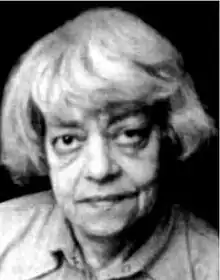
.svg.png.webp)